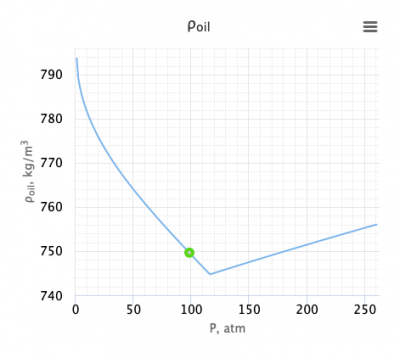Difference between revisions of "McCain Oil density correlation"
From wiki.pengtools.com
(→Example. Calculation of the solution gas oil ratio) |
(→Math & Physics) |
||
| (2 intermediate revisions by the same user not shown) | |||
| Line 23: | Line 23: | ||
:<math>a_5 =- 0.0356888</math> | :<math>a_5 =- 0.0356888</math> | ||
| − | Next pseudoliquid density: | + | Next pseudoliquid density<ref name= M1990/>: |
| − | :<math>\rho_{po} = \frac{R_s\ SG_g + 4,600\ SG_o}{73.71+R_s\ SG_g\ / \rho_a}</math | + | :<math>\rho_{po} = \frac{R_s\ SG_g + 4,600\ SG_o}{73.71+R_s\ SG_g\ / \rho_a}</math> |
Iterate until pseudoliquid densities are equal. | Iterate until pseudoliquid densities are equal. | ||
| Line 34: | Line 34: | ||
where | where | ||
| − | :<math>\triangle \rho_{P} = \left ( 0. | + | :<math>\triangle \rho_{P} = \left ( 0.167 + 16.181 \times 10^{-0.0425\ \rho_{po}} \right) \frac{P}{1000} - 0.01 \left ( 0.299 + 263 \times 10^{-0.0603\ \rho_{po}}\right)\ \left (\frac{P}{1000}\right)^2 </math> |
Adjust density to the temperature of interest: | Adjust density to the temperature of interest: | ||
| Line 120: | Line 120: | ||
|ISBN=978-0878143351 | |ISBN=978-0878143351 | ||
}}</ref> | }}</ref> | ||
| − | + | <ref name=DW> | |
| + | {{cite book | ||
| + | |last1= Wolcott |first1=Don | ||
| + | |title=Applied Waterflood Field Development | ||
| + | |date=2009 | ||
| + | |publisher=Energy Tribune Publishing Inc | ||
| + | |place=Houston | ||
| + | |url=https://www.amazon.com/Applied-Waterflood-Field-Development-Wolcott/dp/0578023946/ref=sr_1_1?ie=UTF8&qid=1481788841&sr=8-1&keywords=Don+wolcott | ||
| + | |url-access=subscription | ||
| + | }}</ref> | ||
</references> | </references> | ||
Latest revision as of 18:41, 23 November 2023
Contents
McCain Oil density correlation
McCain correlation is an empirical correlation for the oil density published in 1995 [1].
Math & Physics
Pseudoliquid density:
Apparent liquid density:
Next pseudoliquid density[2]:
Iterate until pseudoliquid densities are equal.
Next adjust density to the pressure of interest:
where
Adjust density to the temperature of interest:
where
Oil density above the bubble point pressure:
Example. Calculation of the oil density
Example source [3]
Input data
 = 53.24 sm3/sm3
= 53.24 sm3/sm3 = 0.85 or 35 API
= 0.85 or 35 API = 0.75
= 0.75 = 90C or 363K
= 90C or 363K = 10 MPa
= 10 MPa
Calculate oil density at p = 10 MPa?
Solution
 = 749.645 kg/m3
= 749.645 kg/m3
The solution is available in the online PVT calculator software model at www.pengtools.com
Application range
Description of the Data Used[1]:
Number of data sets = 684
Nomenclature
 = oil compressibility, 1/psia
= oil compressibility, 1/psia = pressure, psia
= pressure, psia = solution gas-oil ratio, scf/stb
= solution gas-oil ratio, scf/stb = gas specific gravity, dimensionless
= gas specific gravity, dimensionless = gas specific gravity at separator pressure, dimensionless
= gas specific gravity at separator pressure, dimensionless = oil specific gravity, dimensionless
= oil specific gravity, dimensionless = temperature, °F
= temperature, °F
 = apparent density of surface gas if it were a liquid, lbm/ft3
= apparent density of surface gas if it were a liquid, lbm/ft3 = liquid density at the bubble point pressure, lbm/ft3
= liquid density at the bubble point pressure, lbm/ft3 = liquid density at reservoir pressure and 60°F, lbm/ft3
= liquid density at reservoir pressure and 60°F, lbm/ft3 = oil density, lbm/ft3
= oil density, lbm/ft3 = pseudoliquid formed by recombination of surface gas and liquid at standard conditions, lbm/ft3
= pseudoliquid formed by recombination of surface gas and liquid at standard conditions, lbm/ft3 = adjustment to liquid density due to pressure, lbm/ft3
= adjustment to liquid density due to pressure, lbm/ft3 = adjustment to liquid density due to temperature, lbm/ft3
= adjustment to liquid density due to temperature, lbm/ft3
Subscripts
- b - bubble point
- g - gas
- o - oil
References
- ↑ 1.0 1.1 McCain, W.D. Jr.; Hill, N. C. (1995). "Correlations for Liquid Densities and Evolved Gas Specific Gravities for Black Oils During Pressure Depletion"
 . Society of Petroleum Engineers (SPE-30773-MS).
. Society of Petroleum Engineers (SPE-30773-MS).
- ↑ McCain, W.D. Jr. (1990). Properties of Petroleum Fluids (2 ed.). Oklahoma: PennWell Corp. ISBN 978-0878143351.
- ↑
Wolcott, Don (2009). Applied Waterflood Field Development
 . Houston: Energy Tribune Publishing Inc.
. Houston: Energy Tribune Publishing Inc.





















